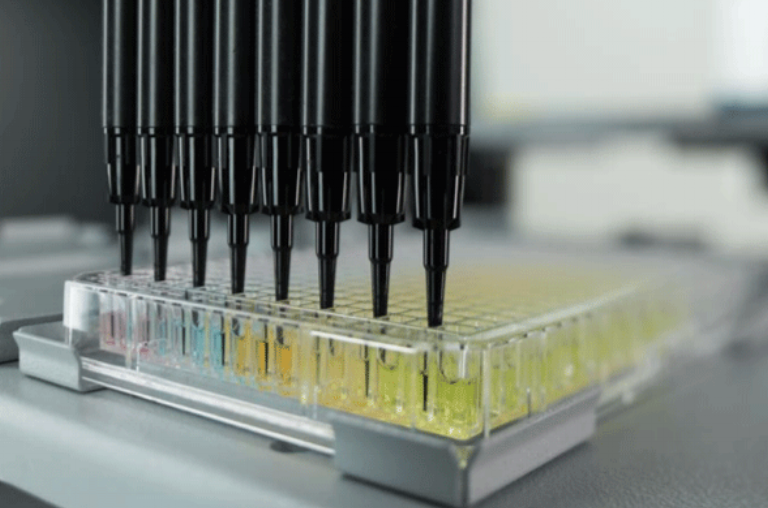By Severin Heynen
With multiple tests to perform on a tiny volume, samples are getting more precious. And as Next Generation Sequencing pushes the envelope on cost and throughput, scientists are looking for ways of reducing reagent volumes without compromising on quality. Tecan has a tip.

Quality and precision in low volume pipetting – time and time again
The industrialization of biology has become possible thanks to the automation of repetitive tasks such as liquid handling, making 24/7 operation perfectly feasible today. Beyond cost-saving, automation addresses two major concerns: minimizing error and avoiding low-value work. Automation means consistency, reducing the risk of expensive errors that can delay the publication of your paper, or hold up a drug development project. Implementing low-error automation can be critical to regulatory acceptance in clinical applications, for example. Automation enables personnel to concentrate on their irreplaceable competencies and make the lab become more productive as a whole.
The drive to generate more data from the same sample has also created a demand for secure downscaling of volumes. Migrating manual work such as pipetting to robotic control enables you to downsize formats including sample and reagent volumes. Reducing the volume results in cost-savings in both reagent and sample use. This is especially relevant when very sensitive assays are used to screen libraries of potential drug candidates that are available in very limited amounts.
Downsizing the dispensing volume does pose higher quality criteria on the manufacture of disposable low volume pipette tips. Liquid handling platforms that use system-matched validated tips are now capable of accurate dispensing at the microliter or sub-microliter level, which can be critical, as we will see in two examples: Next Generation Sequencing (NGS) and cell-based assays.
Next Generation Sequencing – achieving economy of scale
Massive technological advances in DNA sequencing have reduced the cost of sequencing the human genome from $10M to $1,000 in less than 10 years. A major driver has been the development of Next Generation Sequencing (NGS) methods which have shifted bottlenecks during downscaling and automation. As a result, library preparation, with its many tedious and error prone steps, has become critical. Each library must be carefully prepared using time-consuming and resource-intensive processes (see further reading). Automation of library preparation minimizes errors, reduces hands-on time, and increases throughput. Automating sample preparation can, for example, ramp up the efficiency of NGS-based clinical trials and improves the chances of success in a clinical development project.
Success in many NGS protocols builds on accurate and reproducible dispensation of carefully quantified library samples to ensure optimal cluster generation. Controlled dispensation of small volumes also helps conserve expensive reagents. Making mistakes results in time-consuming and expensive repeating of the sequencing runs. To meet this need, automated library preparation is now within the reach of most labs interested in streamlining their NGS processes.
More with less – high precision sub-microliter dispensation for cell-based assays
Consistently generating more data from less sample and reagents relies on dispensing small volumes accurately and reproducibly. To this end, Tecan has developed a portfolio of new 10µl disposable pipette tips that have precise sub-microliter liquid handling and improved labware compatibility. The result is improved success rates in many applications, including genomics research, cell-based assays, forensics, molecular diagnostics, and microbiology.
The new 10μl tips from Tecan enable you to pipette as little as 0.5μl with confidence. This gives an important advantage in applications that require low volume pipetting due to high assay sensitivity, the high costs of reagents or the scarcity of the sample.
A further benefit is that the new 10μl tips are longer, enabling you to use a wider range of labware with deeper wells, such as PCR and 384-well plates. The carrier choice is flexible, with a range of formats, including Standard Tray, ANSI/SLAS tray, and nested format, which improves throughput and increases the time you can turn your back on the system and let it get on with the work. Tecan’s 10µl disposable tip portfolio can be used with the Liquid Handling Arms and Flexible Channel Arms of Tecan Fluent® and Freedom EVO® liquid handling platforms.
The 10µl disposable tips are available in non-filtered and filtered formats at two purity levels:- Tecan Pure has been developed for genomics research, forensics and molecular diagnostics. These tips are guaranteed free from human DNA, PCR inhibitors, RNase, and DNase.
- Tecan Sterile for cell-based assays and screens, and microbiology applications. These tips are guaranteed sterile and free from human DNA, RNase, DNase, pyrogens, and endotoxins.
Quite indispensable
These new high performance tips, combined with the precision of automated liquid handling, will provide you with a stable platform to develop robust assay protocols that help you consistently generate more data from less sample and in less time.
Further reading
Inexpensive multiplexed library preparation for megabase-sized genomes. Baym M. et al PLoS One. 2015 May 22;10(5):e0128036. doi: 10.1371/journal.pone.0128036. eCollection 2015. https://www.ncbi.nlm.nih.gov/pubmed/26000737 and https://www.ncbi.nlm.nih.gov/pubmed/26086768 (erratum)
Improved workflows for high throughput library preparation using the transposome-based Nextera system. Lamble S. et al BMC Biotechnol. 2013 Nov 20;13:104. doi: 10.1186/1472-6750-13-104. https://www.ncbi.nlm.nih.gov/pubmed/24256843
About the author

Dr Severin Heynen
Dr. Severin Heynen joined Tecan in 2015 as a product manager responsible for the disposable tip consumables. In his PhD studies at the University of Zurich, he mainly used biochemical and molecular biology techniques to study the mechanisms of retinal degenerative diseases.











